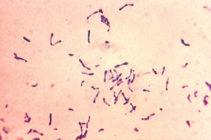1973
Dr. P.B. Smith
This photomicrograph depicted a number of Gram-positive Corynebacterium diphtheriae bacteria, which had been stained using the methylene blue technique. The specimen was taken from a Pais slant culture.
Diphtheria is an acute bacterial disease caused by toxigenic strains of Corynebacterium diphtheriae and occasionally C. ulcerans. It is transmitted through respiratory droplets and personal contact. Diphtheria affects the mucous membranes of the respiratory tract, known as respiratory diphtheria, the skin, termed cutaneous diphtheria, and occasionally other sites including the eyes, nose, or vagina. Diphtheria remains a serious disease throughout much of the world. In particular, large outbreaks of diphtheria occurred in the 1990s throughout Russia and the other former Soviet republics. Most life-threatening cases occurred in inadequately immunized persons. Travelers to disease-endemic areas are at increased risk for exposure to toxigenic strains of C. diphtheriae.





